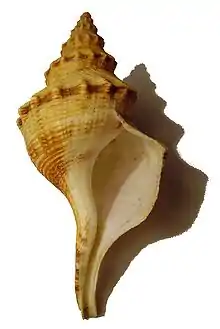Siphonal canal
The siphonal canal is an anatomical feature of the shells of certain groups of sea snails within the clade Neogastropoda. Some sea marine gastropods have a soft tubular anterior extension of the mantle called a siphon through which water is drawn into the mantle cavity and over the gill and which serves as a chemoreceptor to locate food. In certain groups of carnivorous snails, where the siphon is particularly long, the structure of the shell has been modified in order to house and protect the soft structure of the siphon. Thus the siphonal canal is a semi-tubular extension of the aperture of the shell through which the siphon is extended when the animal is active.

One gastropod whose shell has an exceptionally long siphonal canal is the Venus comb murex. Some gastropods have a simple siphonal notch at the edge of the aperture instead of a canal.
See also
References
Further reading
- Vermeij G. J. (2007) "The ecology of invasion: acquisition and loss of the siphonal canal in gastropods". Paleobiology 33(3): 469-493. doi:10.1666/06061.1.